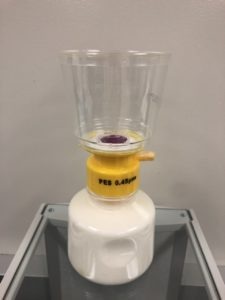May 7 2019
A new sensor technology developed by researchers at Washington State University scientists could eventually make expiration dates on milk a thing of the past with.
 The experimental setup for detecting the volatile compounds in milk, with the pink nanoparticles seen above the liquid. (Image credit: Washington State University)
The experimental setup for detecting the volatile compounds in milk, with the pink nanoparticles seen above the liquid. (Image credit: Washington State University)
Scientists at the Department of Biological Systems Engineering (BSE), the WSU/UI School of Food Science and other departments have created a sensor with the ability to “smell” whether milk is still fresh or has gone sour.
Shyam Sablani, a professor in BSE, stated that the sensor is made up of chemically coated nanoparticles that respond to the gas synthesized by milk and the bacterial growth that signals spoilage. However, the sensor does not come into direct contact with the milk.
If it’s going bad, most food produces a volatile compound that doesn’t smell good. That comes from bacterial growth in the food, most of the time. But you can’t smell that until you open the container.
Shyam Sablani, Professor, Department of Biological Systems Engineering, Washington State University
Upon detecting volatile gases, the sensor changes color.
Although the discovery is in its early stages, Sablani and his coworkers demonstrated in a paper reported in the journal Food Control that their chemical reaction works in a controlled lab environment.
The next stride for the researchers would be to develop a means to visually indicate the time left for a product before it spoils. At present, the sensor only indicates whether milk is good or spoiled.
It is still very early, but Sablani anticipates to work with the food industry to incorporate his sensor into the plastic cap of a milk bottle to enable consumers to easily see how long the product will stay fresh.
One challenge with existing expiration dates is that they are dependent on best-case scenarios.
The expiration date on cold or frozen products is only accurate if it has been stored at the correct temperature the entire time.
Shyam Sablani, Professor, Department of Biological Systems Engineering, Washington State University
He said that it is very common to come across temperature abuse, or the time a product has spent above refrigerator temperature. Moreover, this can occur during shipment, or if a consumer gets delayed while going back to the home from the store.
“We’ll have to work with the industry to make this work,” stated Sablani. “But we’re confident that we can succeed and help improve food safety and shelf life for consumers.”